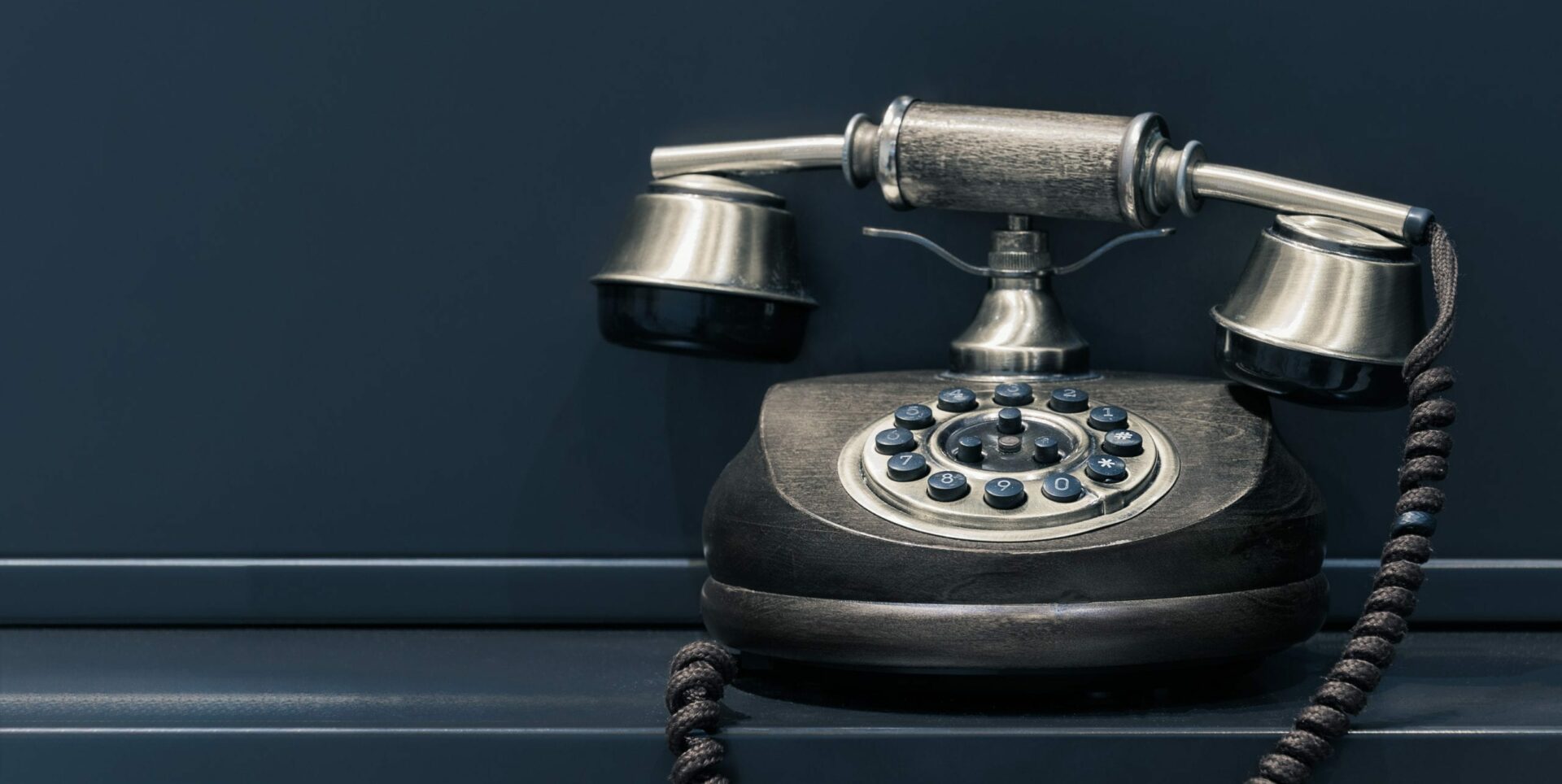15 phone sales tips: simple strategies to help you sell more

Selling over the phone can be a tricky business. There’s no body language to pick up on and no eye contact, but you still need to build rapport and make an impression.
These phone sales tips should help make sure you aren’t forgotten the second they’ve hung up.
Cold calling, warm calling, tepid calling….
Cold calling is increasingly being given the cold shoulder. Multi-touchpoint marketing campaigns – covering search engine marketing, email prospecting, social media and influencers, and much more – are widely accepted as a more advanced way to connect with prospects.
But cold calling can still see results, especially when used alongside other channels. And once you get to the end of the buyer’s journey, there’s little option but to pick up the phone.
I say phone… in the era of virtual selling, it’s more likely that you pop a shirt over your pyjamas, turn on a virtual background, and fire up your video call software of choice.
Whatever stage of the buyer journey you are looking at, these 15 tips and tricks for selling on the phone will help move leads through the sales funnel.
Calls to action: practical sales call tips
Whether it’s a discovery call, a follow-up, an outbound call, or closing a deal, these phone sales tips should improve every sales call you make.
We’ve found that reps can often tweak a few small things in their approach and see instant benefits.
It’s all in the timing
Evidence suggests there are two periods in the working day that are more likely to lead to a successful sales conversation.
Calls made either in the late morning or toward the end of the day are more likely to land.
The first period follows a rush of emails, meetings, and other tasks. It’s a fruitful time before people break for lunch.
And the hour before the end of the day works because the potential client is less likely to see your call as an interruption.
Call script or call structure?
Reading from a script is a surefire way to lower your close rates. As you get more used to the words, you become more robotic. The last time I looked, Daleks had a terrible close rate.
However, having a structure that groups topics together can be very beneficial.
It makes the conversation follow a familiar pattern and allows you to get across your main selling points, but it’s also easier for the prospect to follow and remember these points.
The call will still be able to flow naturally, with questions from the prospect picked up and answered as they arise without upending any script.
Never shoot without a goal
Every call you make must have a clear goal in mind, be it discovering your prospect’s pain points, establishing who is involved in the buying decision or simply setting a time for another meeting to move things forward.
Before any call, sales professionals should have a clear understanding of their goal. Often, having a simple structure for the call can make sure nothing is missed and the conversation flows naturally to the goal.
Listen more than you talk
On that point, although you are doing the selling, one of the key aspects of a good call is listening. Saleshacker reports that top sellers talk for a maximum of 46% of a sales call. Whereas poorer performers chatter away for over 68% of the time.
By giving the prospect space to talk, you turn it into a two-way conversation, allow them to direct you to the points that matter to them, and find out more about their use case.

Who’s afraid of the big, bad voicemail?
We all hate that distinct click as the voicemail kicks in, but do not hang up without leaving a message.
And better still fire up your email and ping a brief ‘sorry to miss you’ over to your prospect.
Research from Forrester suggests it may take eight to twelve attempts to reach a decision-maker by phone, so leave a message and send a mail to make the most of each attempt.
As the number of attempts increases, a little bit of lighthearted humour can make you stand out. We’ve found that adding a funny email to the end of a sales outreach sequence can drive great results when all seemed lost.
Focus on benefits
This is one that every salesperson covers when first learning how to sell, but it’s worth repeating.
Focus on the outcomes and benefits rather than processes and tech.
Buyers tend to be far less interested in how something works, than the results they’re going to get and how the product or service can make their life easier or their company stronger. Spend more time on demonstrating business value, and they will be able to imagine an easier life with your product at the centre.
One way to achieve this is to cover case studies and relevant results your solution can deliver. There is little better way to show the successes you can drive than demonstrate where you have already done that with a similar business.
Build relationships
People don’t just buy things – they buy from people. And the people they buy from are much more likely to be those they know, like and trust.
As they say, ‘You can’t close a sale until you have opened a relationship.’
So as every superstar seller knows, you need to build rapport. Even small things like engaging on social media before a call, can help grease the wheels.
There are many other tactics – each sales rep should find ways that feel comfortable for them.
Discuss competitors
Prospects will be looking at multiple solutions, and both of you know this. But how and when you address it can make a big difference.
When dealing with the competition, do it early in the sales cycle and your chances of closing a deal increase by 49%. It’s also important to avoid bad-mouthing them; it comes across as unprofessional and unpersuasive. You can acknowledge they have strengths, but outline why you are a better fit.
Follow the leader
Those who fail to follow up on their leads, fail.
Chasers, follow-ups and subtle reminders are what keep sales progressing. And silence rarely sells.
As part of your sales process – and before a single phone call has been made – the potential customer should discover multiple touchpoints with your brand. Whether through social media, PPC, email prospecting, they should be led along the journey you want them to take.

Stay on schedule
Here’s a very simple and easy phone sales tip. It comes from the simple fact that an unscheduled call is often a call that does not get made.
In the heat and excitement of other opportunities, follow-up calls can be hard to keep track of. Place them in your diary and avoid the temptation to endlessly snooze them every time a reminder appears on screen.
The stats are strongly in favour of those who keep in touch:
- 47% of buyers want to hear regular personalised communication
- 82% of buyers accept meetings with sales prospectors who continue to proactively reach out
Unlock sales by nothing key points
You must listen actively on every sales call.
But don’t also forget to give your prospect feedback that tells them you have listened actively.
Those who listen and feedback effectively during a sales call are more likely to establish trust, encourage prospects to open up further and pinpoint the exact nature of each prospect’s pain point.
Again, the stats are on your side:
- 42% of buyers highly value active listening
- 56% strongly agree that they consider solutions when a salesperson demonstrates a clear understanding of their problems
Meet objections head-on
Common sales objections expressed during conversations on the phone will range from a lack of budget to a lack of trust in your company.
Through intelligence gained on previous calls, you’ve probably answered most concerns already.
However, as we know from Jaws II, you can never assume it’s safe to go back in the water. Prospects can often get cold feet or raise concerns as they head towards the end of the buying journey.
Never brush such objections aside. Simply
Hold off on the price chat
Don’t talk about pricing until later in the call. An analysis of one million sales calls found that the lowest-performing sales reps talk about pricing in the first 15 minutes.
The best performing hold off until around the 40-minute mark and beyond. The idea is to have demonstrated value by the time the money conversation starts, so they think “well that’s good value considering how much it will help us”.
Have great collateral
If sales and marketing are aligned, your marketing team should have created some great sales collateral for you that can help move closer to the close.
Whether it’s a company presentation, product details, case studies, or collateral that tackles the competition head-on, having well-presented documentation can help reassure the prospect and bring other stakeholders on board.
The end is nigh
Recognising that the time for selling is over and the time for closing is here is a critical skill.
Before you make that close, ask yourself the following questions:
- Have I fully described and demonstrated my solution’s ability to meet their needs?
- Have I demonstrated this with proof – results, case studies, etc.
- Have I covered any doubts or objections?
- Does it feel like asking for a final answer is the right thing to do?
If you’re trying to drive conversion rates from lead to sale, I hope you find these phone sales tips practical, actionable, and they help you close a few more deals.
If you want more leads for your sales funnel, you’ve come to the right place. We’re Sopro, the award-winning and best-in-class prospecting agency. Why not have a chat with us – we’re good at starting conversations.




Share